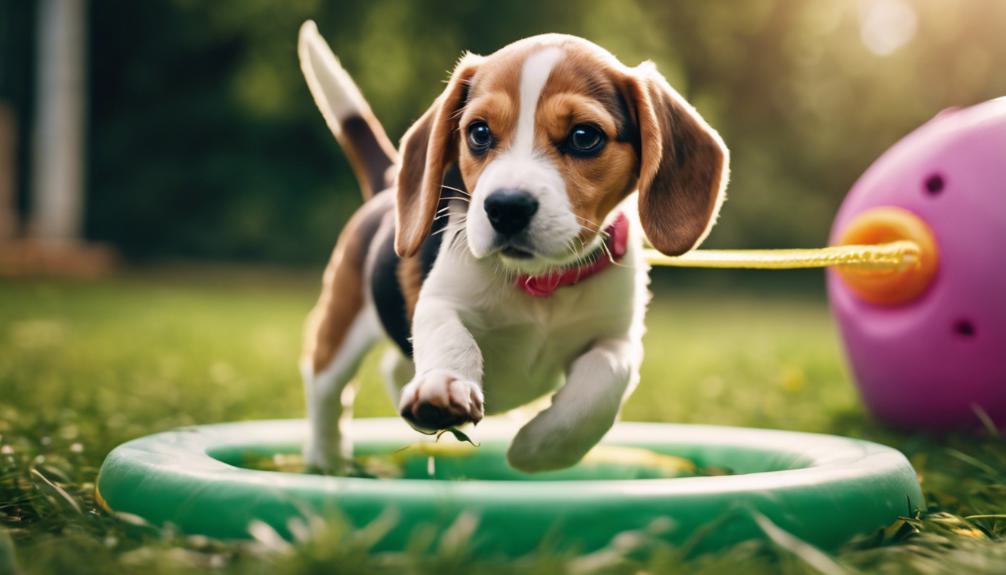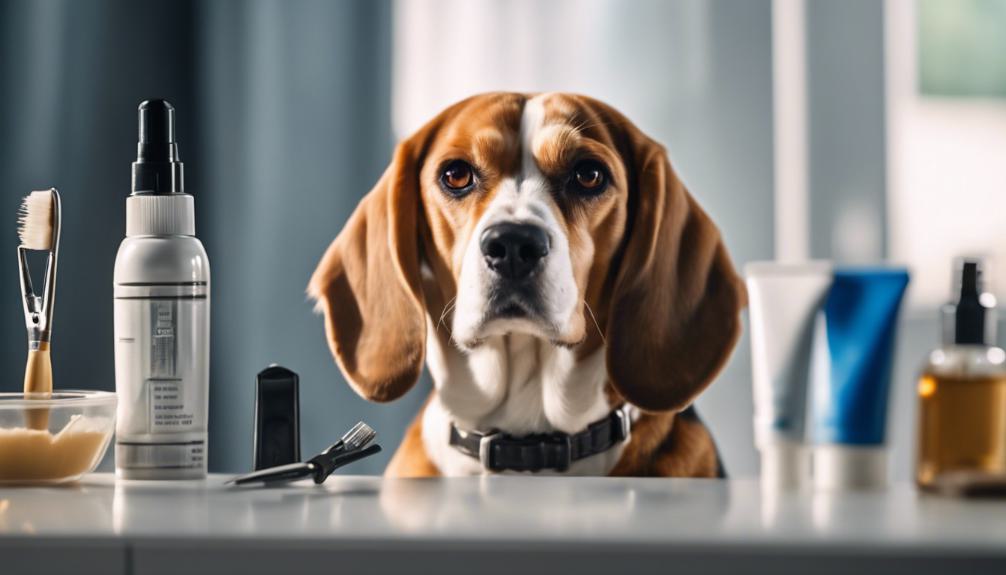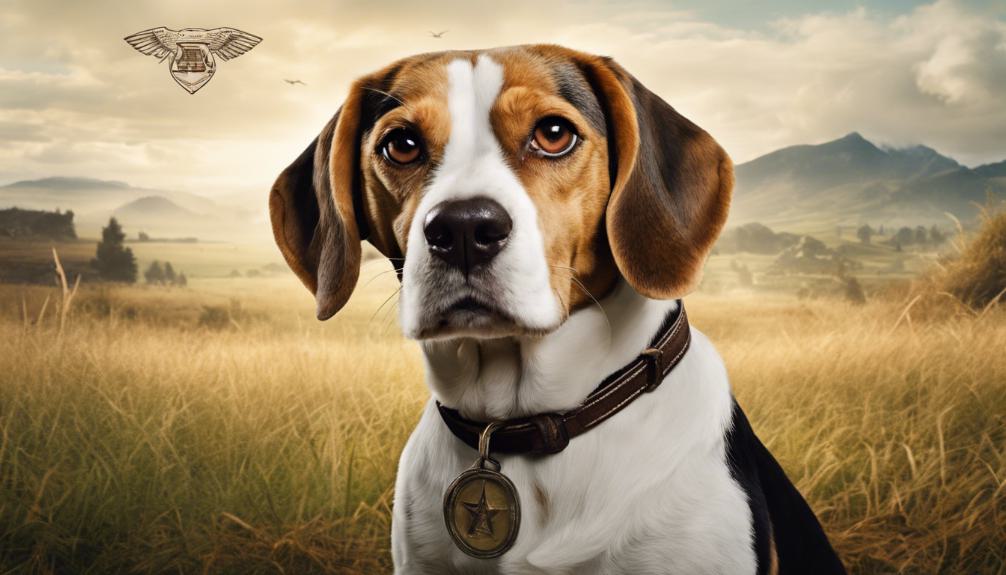Beagle Dog Breed: History, Personality Traits, and Care
Beagles, originally from England around 200 A.D., were bred for hunting but have evolved into friendly family pets. They’re energetic critters, often mistaken for being stubborn due to their strong tracking instinct. This breed stands up to 15 inches tall and typically weighs between 20-25 pounds. Known for their tri-colored coat and distinctive white-tipped tails, Beagles require a good hour of exercise daily and regular grooming. Their diet and overall health also need careful monitoring to prevent obesity. With more knowledge, you’ll be prepared to offer the best care for this seventh most popular U.S. breed. There’s always more to learn – ready for the next chapter?
Beagle Breed Overview
Let’s explore the world of the Beagle, a hound breed that stands no more than 15 inches tall and weighs between 20 to 25 pounds, known for its short, tricolor coat and origins dating back to 16th-century England.
This breed, officially recognized by the American Kennel Club (AKC) in 1885, is loved for its energetic, carefree, and optimistic temperament. It’s a great fit for active households, as Beagles thrive on daily exercise and companionship, whether it’s human or pet.
When it comes to grooming, their short coat does need regular attention, but it’s not a challenging task. All in all, the Beagle’s charming personality and manageable grooming requirements make it a popular choice among dog lovers.
Detailed History of Beagles
You’re about to journey through the fascinating history of Beagles, a breed with origins tracing back to England around 200 A.D.
We’ll explore how they were designed for hunting and how their breed standards got established in the 1800s.
We’ll also discuss their migration to the U.S. and how their distinctive white-tipped tails became a trait of great utility in the field.
Beagles Origin and Evolution
Tracing back to around 200 A.D. in England, Beagles were originally bred for hunting rabbits and hares. This dog breed, standardized in the 1800s, was brought to the United States after the Civil War.
The Beagles’ keen sense of smell and tracking instinct made them a favorite among hunting dog breeds. In the U.S., they quickly gained popularity, and today, they rank as the seventh most popular breed.
Fun fact? Their white-tipped tail, a trait bred into them, helps hunters track them in the field. And you mightn’t know this, but the lovable Snoopy from the Peanuts comic strip is a Beagle.
Historical Roles of Beagles
Diving into their historical roles, you’ll find that Beagles have served not just as skilled hunting dogs, but also as beloved family pets. Originating in England around 200 A.D., they were employed for hunting rabbits and hares. Their impressive tracking abilities were so revered that these breeds were standardized in the 1800s for precisely these skills.
Post-Civil War, Beagles made their way to the U.S., quickly gaining popularity. Their white-tipped tail, a distinctive feature, wasn’t just for looks; it was intentionally bred for visibility during hunts. So, from hunting companions in the English countryside to being treasured family pets worldwide, Beagles have certainly made their mark, thanks to their unique combination of hunting prowess and endearing personalities.
Beagles Physical Characteristics

You’re probably curious about the physical aspects that define a Beagle, right?
Well, let’s start with their size and weight.
Then, we’ll look into the variety of their coat colors and why grooming a Beagle can be a unique experience.
Beagles Size and Weight
Falling into the small to medium-sized hound category, your Beagle typically weighs between 20-25 pounds and stands 15 inches or less at the shoulder. This compact size makes them ideal for those living in apartments or homes with smaller yards. Despite their size, they’re sturdy and solid with a square muzzle and slightly domed skull. Their long, droopy ears add to their charm.
They’re not just adorable, they’re also practical. Their size and weight make them agile, able to move quickly when they’re on a scent. Their coat, while short and smooth, is weather-proof, requiring regular grooming to maintain. So, while their size mightn’t be imposing, their weight, coat, and inherent agility make the Beagle a breed that’s hard to resist.
Coat and Color Variations
Regarding their coat, Beagles boast a short, smooth texture that’s not only weather-proof, but also comes in a variety of colors, including tricolor combinations of black, light brown, and white. This coat serves as insulation and protection against the elements, contributing to the breed’s distinctive and attractive appearance.
Now, don’t ignore the fact that Beagles shed moderately. Yes, shedding is an issue but nothing a weekly brushing can’t handle. Regular grooming helps maintain the quality of their coat and keep it clean and healthy. Remember, the coat colors of Beagles can vary, but each one is unique and adds to their charm.
Personality Traits of Beagles
Diving right into the heart of the matter, beagles are known for their friendly, playful, and energetic temperament which shines through in their interactions. As scent hounds, they have a strong tracking instinct, which makes them excellent at hunting. However, they can be stubborn and require consistent companionship to thrive.
Here’s a brief overview of their personality traits:
| Trait | Description | Level of Intensity |
|---|---|---|
| Friendliness | Warm and sociable | High |
| Playfulness | Loves to play, especially outdoors | High |
| Energy | Always on the go | High |
| Stubbornness | Can be independent and hard-headed | Moderate |
| Need for Companionship | Thrives with regular social interaction | High |
Training Your Beagle

Training your beagle might seem like a challenging task given their stubbornness, but with patience, consistency, and the right techniques, it’s easier than you might think. Beagles are quick learners, but their independence can sometimes be mistaken for stubbornness. Using positive reinforcement is key in training, as they’re highly food-motivated. Rewarding them with treats when they follow commands will encourage them to repeat the behavior.
Early socialization is also critical, so introduce them to various environments, humans, and other animals at a young age. This enhances their friendly disposition and prevents future behavioral issues. Remember, training is also about building a strong bond. So, stay patient, persistent, and positive, and you’ll have a well-trained beagle in no time.
Beagles Exercise Needs
To maintain the health and happiness of your Beagle, you’ll need to make sure they get at least an hour of exercise each day. Their exercise needs are high and so is their tendency to follow scents, which can lead to them wandering off. This makes it important to have a secure fence or leash during outdoor activities.
Keep in mind that Beagles are prone to loneliness, which can result in behavioral problems. Regular exercise, combined with plenty of social interaction, will help prevent these issues. Activities like scent tracking work great for mental stimulation, satisfying their natural instincts.
Grooming Tips for Beagles

In ensuring your Beagle maintains their best appearance, regular grooming is essential, encompassing weekly brushing, ear cleaning, nail trimming, and careful bathing. Meeting their grooming requirements, you’ll start with a weekly brush to minimize shedding and keep their coat looking healthy.
Ear cleaning is crucial due to their floppy ears which can trap moisture and dirt, leading to infections. As a result, regular cleaning is a must.
You’ll need to trim their nails every 1-2 months to prevent discomfort. Bathing should be done as needed, but be careful; use mild dog shampoo to avoid causing skin irritation.
Health Concerns in Beagles
While Beagles are generally healthy dogs, they’re prone to certain health issues such as epilepsy, hypothyroidism, intervertebral disc disease, and progressive retinal atrophy. As a Beagle owner, your role in safeguarding your furry friend’s health is essential.
- Regular Physical Exercise: Keep your Beagle active to prevent obesity and maintain overall health.
- Proper Grooming: Clean their ears, trim their nails, and brush their teeth regularly to avoid infections and other hygiene-related health issues.
- Balanced Diet: Monitor their diet and nutrition to prevent obesity and maintain overall health.
Adopting or Buying Beagles

Before you decide to bring a Beagle into your life, it’s important to do your homework and understand what you’re getting into. Research reputable breeders through trusted sources like the AKC search tool or the National Beagle Club of America website.
Don’t hesitate to inquire about health issues in the Beagle’s bloodline. You might also consider adopting a rescue Beagle from local shelters or organizations. Beagles are known for their adventurous spirit, so make sure your home has secure exits and a yard to prevent them from running off.
Above all, a nurturing environment is critical for Beagle puppies to thrive and develop, so make sure you’re ready to provide that before bringing one home.
Frequently Asked Questions
What Traits Were Beagles Bred For?
You’re asking about the traits beagles were bred for. They were bred primarily for hunting small game, thanks to their keen sense of smell, agility, cooperative nature, and unique vocalization. These traits made them exceptional hunters.
What Is the Attitude of a Beagle?
You’ll find beagles to be friendly, playful, and energetic. They’re social animals who get along well with others. However, they can be independent and stubborn, requiring consistent, positive reinforcement training. They don’t tolerate loneliness well.
What Is the Personality of a Beagle Owner?
You’re patient, consistent, and empathetic, often indulging in outdoor activities. You love spending quality time with your playful beagle, ensuring regular exercise, grooming, and socialization for a well-rounded pet. Training and mental stimulation are your priorities.
What Is the History of the Beagle Dog Breed?
You’re curious about the Beagle’s history? Originating in England around 200 A.D., they were used for hunting small game. Post-Civil War, they were brought to the U.S, becoming the seventh most popular breed.
Conclusion
So, you’re considering a Beagle, huh? Well, these compact, sniffer-extraordinaire pups are full of personality and charm.
Remember, their history as a hunting hound means they need ample exercise. Keep that coat sleek with regular grooming, and stay vigilant for health concerns.
Whether adopted or bought, with appropriate training, your Beagle will be a loyal companion. Immerse yourself, they’re a breed worth loving.
Just be ready for a tail-wagging, nose-to-the-ground adventure!

